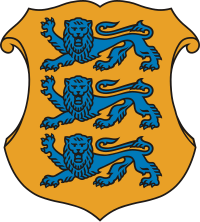Estonian Defence Forces
| Estonian Defence Forces Eesti Kaitsevägi |
|
|---|---|
 |
|
| Service branches |
|
| Headquarters | Tallinn |
| Leadership | |
| Commander of the Defence Forces | General Riho Terras |
| Minister of Defence | Margus Tsahkna |
| Chief of Staff of the Headquarters | Brigadier General Martin Herem |
| Manpower | |
| Military age | 18 |
| Conscription | 8 or 11 months |
| Active personnel | 5,750 (Defence Forces) 12,000 (Defence League) |
| Reserve personnel | 30,000 |
| Expenditures | |
| Budget | €477 million (2017) |
| Percent of GDP | 2.2 % (2017) |
| Related articles | |
| History |
Estonian War of Independence World War II Iraq War War in Afghanistan |
| Ranks | Military ranks of Estonia |
The Estonian Defence Forces (Estonian: Eesti Kaitsevägi) is the name of the unified armed forces of the Republic of Estonia. The Estonian military is a defence force consisting of Land Forces, Navy, Air Force and a paramilitary organization Defence League. The national defence policy aims to guarantee the preservation of the independence and sovereignty of the state, the integrity of its land area, territorial waters and airspace and its constitutional order. Its main goals remain the development and maintenance of a credible capability to defend the nation's vital interests and development of the defence forces in a way that ensures their interoperability with the armed forces of NATO and European Union member states to participate in the full range of missions for these military alliances.
After the German Revolution, between 11 and 14 November 1918, ending the German occupation in Estonia, the representatives of Germany formally handed over political power to the Government of Estonia. A few days later Estonia was invaded by the military forces of Bolshevist Russia, marking the beginning of the Estonian War of Independence. The small, poorly armed Estonian military, also known as the Peoples Force (in Estonian: Rahvavägi), was initially pushed back by the Red Army into the vicinity of the capital city of Estonia - Tallinn. A mere 34 kilometers separated Tallinn and the front line. Partly due to the timely arrival of a shipment of arms brought by a British naval squadron the Bolsheviks were stopped.
...
Wikipedia
